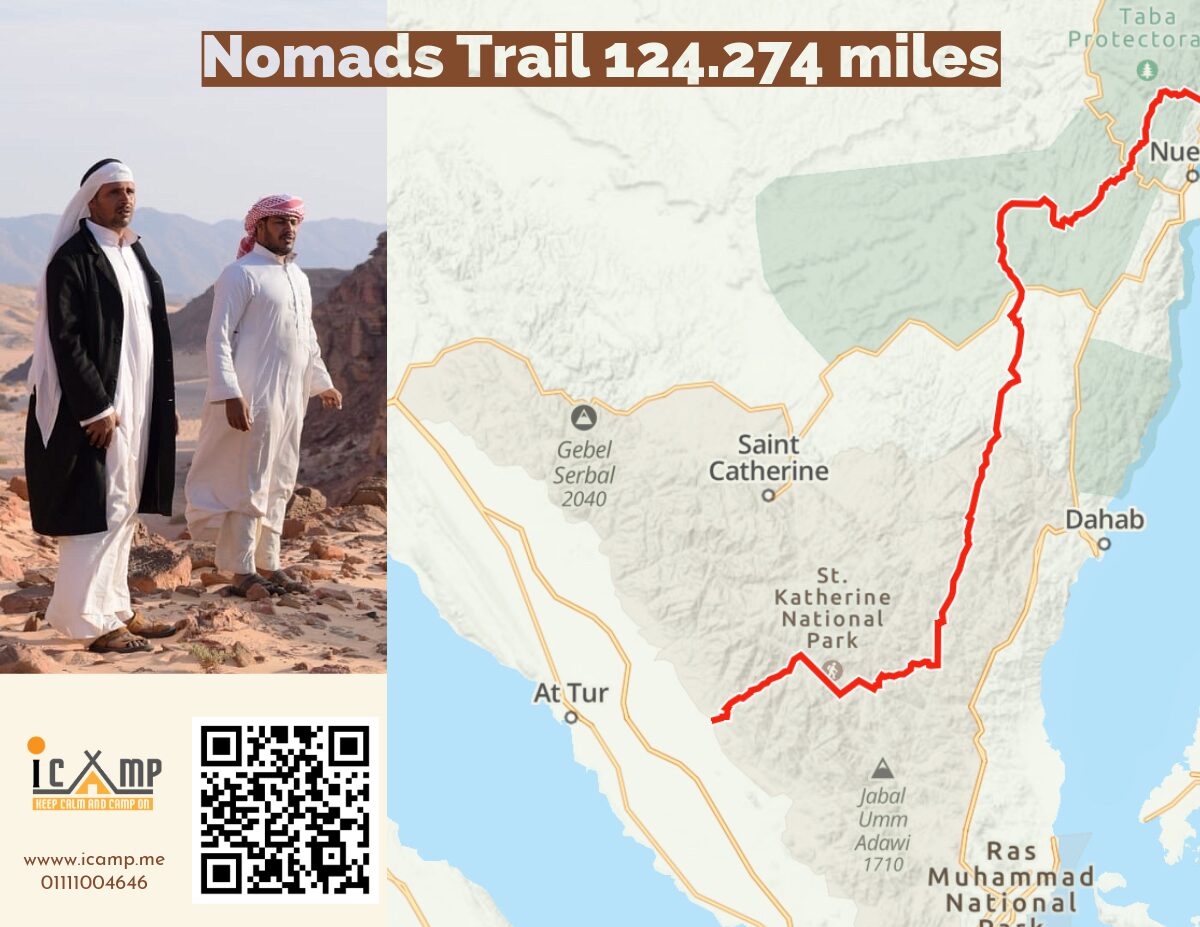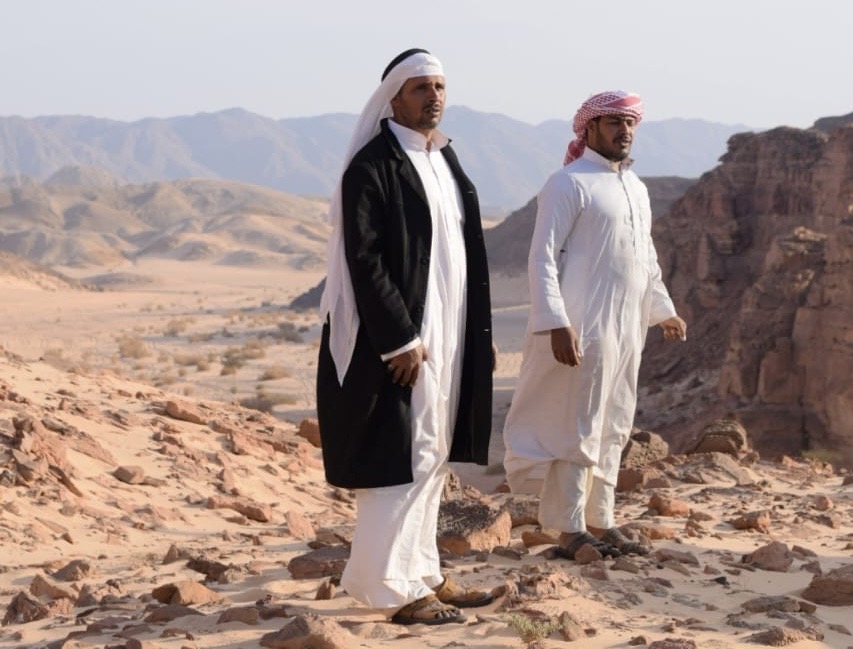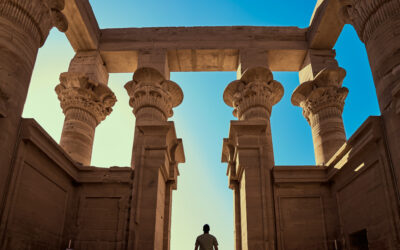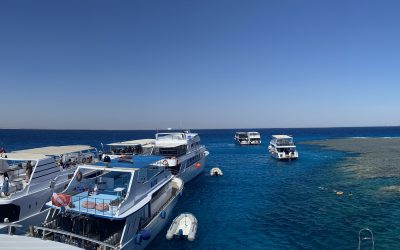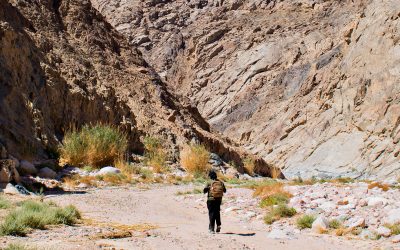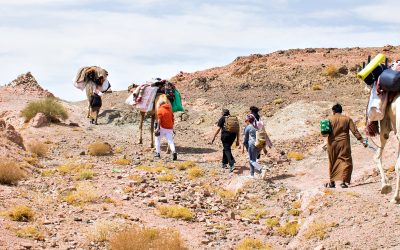“Bedouin Trail”
It is the longest mountain trail in South Sinai, extending from the Gulf of Aqaba to the Gulf of Suez, across diverse terrains including valleys, mountains, and oases. It combines historical trails taken by the Nabataeans, pilgrims, and monks. The trail passes through several paths used by Bedouins in their wanderings in search of pasture and resources. These paths are often invisible to the eye and require a strong knowledge of the area.
The importance of the “Bedouin Trail” for us:
– Documenting the unique Bedouin traditions and culture of the Bedouins of Sinai and reviving the Bedouin heritage
– Providing income for the Bedouins and supporting them
– Promoting ecotourism
– Living the Bedouin life, tasting their traditional foods, and interacting with them
– Exploring the picturesque nature of Sinai and learning to coexist with the surrounding environment
– Promoting tourism in Sinai and making it a global destination for nature and adventure lovers
The challenges we face:
– Climate fluctuations
– Urbanization that erases important terrain and reduces areas suitable for hiking
– Political conflicts and challenges that may affect freedom of movement from one place to another
– The impact of technology on lifestyles Traditional
The trail is between 200 and 300 kilometers long and passes through famous areas. It starts from Taba and passes through Wadi Watir, Wadi Ghazala, Wadi Al-Kaid, Wadi Asla and ends in Al-Tur. However, it passes through the path of our master Moses. The duration of the trip ranges between 8 and 18 days, and of course we advise participants to use basic camping equipment and comfortable shoes.
The trip is a challenge for participants, as it requires walking for long hours across diverse terrain, which has earned it the name “Bone-Crushing Trip” among adventurers. For this reason, Hani Al-Khalili, founder of iCamp, supervises the organization of the “Bedouin Trail” trip, benefiting from his extensive experience in the field of safari and camping, in cooperation with the Bedouin tribes of Sinai from Al-Mazina, Al-Tarabin, Al-Jabaliyya, and Awlad Saeed, to ensure a safe and enjoyable experience for participants.
The “Bedouin Trail” aims to revive the paths that Bedouins took to move around the Sinai wilderness over the centuries, and transform them into tourist paths that allow visitors to explore the picturesque nature and unique cultural heritage.
As for “Hani Al-Khalili”, he is an Egyptian traveler and one of the pioneers of safari trips in Egypt, as he contributed greatly to reviving the “Bedouin Trail” with the aim of introducing participants to the charming nature of Sinai, communicating with the locals, and learning about their culture and traditions
The Nomad Trail is the longest safari, hiking and camping trip in South Sinai (125 miles, 8 days)
It’s the most interesting trip with advanced level of camping, suitable for everyone with average fitness level.
Long Trips – Limited Edition – Limited Travelers
*The first day,
(Nuweiba, Gulf of Aqaba, The Taba Reserve)
– Seil Al-Malha, Al-Weshwashy, Al-Ain Al-Malha, Al-Farie, Naqb Al-Kahla, Al-Mutaresh, Wadi Nekhel, Colored Canyon, Bir Al-Biriya, Wadi Watir Road, Ain Ferjata (We will camp in Bir Al-Biriya or Ain-Hudra).
– The hiking distance is 18 km and the distance in 4×4 vehicles is 20 km.
– Meals of the day: breakfast, snacks during the day, dinner, tea and water.
– There is no mobile network, electricity, or bathrooms. (If we camped in Ain-Hudhra Oasis, there is electricity, a mobile network and bathrooms)
*The second day,
(The Taba Reserve, Nuweiba Desert)
– White Canyon, Arada, Red Canyon (We will camp in Matamir or Arada).
– The hiking distance is 10 km, and the distance in 4×4 vehicles is 15 km.
– Meals of the day: breakfast, snacks during the day, dinner, tea and water.
– There is a mobile network but no electricity or bathrooms.
*The third day, Saturday,
(The Taba Reserve, Nuweiba Desert)
– Matamir, Al-Makhroum, Wadi Al-Hamam (We will camp in Farat Al-Hamam).
– The hiking distance is 10 km, and the distance in 4×4 vehicles is 20 km.
– Meals of the day: breakfast, snacks during the day, dinner, tea and water.
– There is a mobile network but no electricity or bathrooms.
*The Fourth day, Sunday,
(The Taba Reserve, Nuweiba Desert)
– From Wadi Al-Hamam to Naqb Al-Shallala.
– The hiking distance is 12 km, and the distance in 4×4 vehicles is 20 km.
– Meals of the day: breakfast, snacks during the day, dinner, tea and water.
– There is no mobile network, electricity, or bathrooms.
*The fifth day, Monday,
(St. Catherine Reserve, Nabq Protectorate)
– From Naqb Al-Shallala to Wadi Al-Kid, Wadi Ghazala, Aïn Um-Saïda (We will camp in Aïn Um-Saïda).
– The hiking distance is 20 km.
– Meals of the day: breakfast, snacks during the day, dinner, tea and water.
– There is no mobile network, electricity, or bathrooms.
*The sixth day,
(Nabq Protectorate, St. Catherine Reserve)
– Aïn Um-Saïda, Mealaq, Al-Humur, Bir Al-Humur, Khadrif Dam, Al-Aqsuriya (We will Camp in Al-Aqsuriya).
– The hiking distance is 9 km.
– Meals of the day: breakfast, snacks during the day, dinner, tea and water.
– There is no mobile network, electricity, or bathrooms.
*The seventh day, Wednesday,
(St. Catherine Reserve)
– Al-Aqsuriya, Al-Maqadeb, Ismamin, Al-Qasaba, Qtaiteir, Al-Zaraniq, Al-Rafdiya, Hajar Al-Raheb, Karam Meallem, Abu-Sadiyah, Umm Wajid, Al-Sdud (We will camp in Al-Sdud or Al-Qasaba, depending on the percentage of rain).
– The hiking distance is 12 km.
– Meals of the day: breakfast, snacks during the day, dinner, tea and water.
– There is no mobile network, electricity, or bathrooms.
*The eighth day, Thursday,
(Al-Tur city)
– Al-Sdud, Seil-Melaiha, Khurm Hajan, Abu Uthai, Al-Ad, Melaiha, Al-Naqsh, Ariq, Sahl Al-Qaa.
– The hiking distance is 10 km.
– Meals of the day: breakfast, tea and water.
– We will get in 4×4 vehicles for 18 kilograms to Al-Tur, Gulf of Suez.
**The trip includes everything: Transportation, meals, fruits, water, hot drinks, 4×4 vehicles, camels, Bedouin guides, reusable eating tools and sleeping bag.
For all those who travel with us, a trip is not about the hotel, the camp, or even the city you’re visiting. A trip is all about the nature and culture of the place you’re visiting. We don’t travel hundreds of miles to be confined in a small space with walls around us; we travel so that we spend time in a place whose walls are the mountains, whose ceiling is the stars, and whose very spirit is nature itself.
